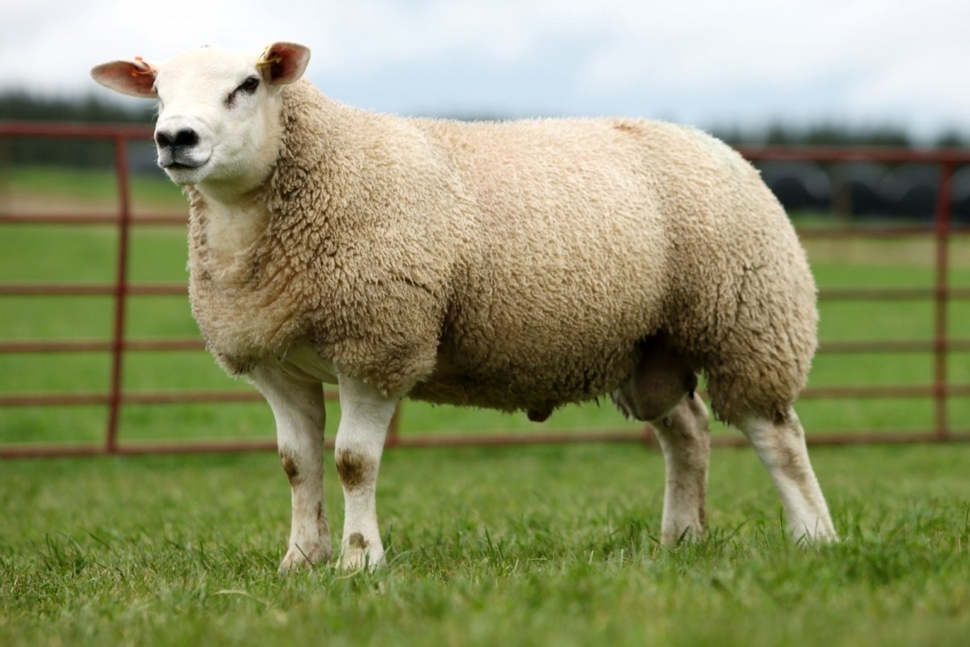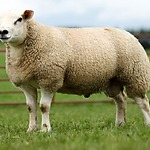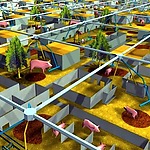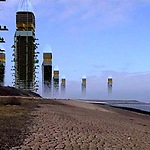3.4 Explore what wider relevant trends, innovative technologies, inspirational initiatives elsewhere and which (groups of) people may need further consideration to steer the TX sub system in the desired direction.
In order to get Texel to be fully sustainable and self-sufficient, it might be necessary to use more technologies, insights or other considerations than are already present at the island. Therefore research has been performed into this area on other places on this planet. These are presented in this section. Firstly, several technologies will be presented, then trends in society that can be seen and lastly some interesting goals of the UN or sustainable food production in the future will be presented.
Technologies, innovations
The first new technology for close-to-home food production that is discussed here is the ‘plantCubeTM’. A product from a young start-up called Agrilution, based in Munich, Germany. Its mission is to provide people with sustainably grown, fresh, tasty and healthy greens. It does so by developing a vertical farming system that is the size of a dishwasher and will therefore be easily integrated in an existing kitchen. The ‘plantCubeTM’ looks like a small-size refrigerator and can be used to grow herbs, lettuce and other small greens inside your own home. Since it might be hard for a farmer to produce all the different herbs that the people of Texel or the restaurant want, this could be a way for the people themselves to grow the greens. It will also eliminate the need for transportation, pesticides and large-scale fertilizers. [1]
Another technology, although it is not an electronical one, is the use of beneficial insects in order to fight pests on the crops that the farmers produce instead of harmful pesticides, it is very much used on islands such as Hawaii and could definitely be beneficial for Texel (if it is not already widely used). [2]
Lastly, more of an innovation, a local/regional food distribution systems are discussed by ‘GRACE’ established in New York, USA. Two variants of this can be used, the first one being a direct-to-consumer market and the second one being the direct to retail, foodservice, and institution market. The first one describes a system where the farmer would directly sell its food to the people of Texel. The second one is the case where there is only one middleperson, which could be something such as a supermarket, but no more corporate that store, process or transport the food to the destined restaurants, supermarkets etc. [3]
Also, there are some new out of the box idea’s like MVRDV’s pig city. They made an concept design where a tower is made for pigs. On the upper floor pigs are born and when they reach the bottom they are slaughtered. This concept was planned on the Maasvlakte near Rotterdam. [4].
[4] Concept design for pig towers by MVRDV
Trends
Different trends that can definitely be seen everywhere on the world are the following. It becomes more of a spread awareness that a lot of food is wasted. The consumer at home starts preventing this by using apps and websites that help you gather left-overs and making a full meal of this. Farmers for instance try to sell ‘abnormally grown’ vegetables in other forms to still make them attractive to the public. Such as strange-looking carrots, that are being cut and sold as baby-carrots for more money.[5] People are become also more and more aware of what’s in their food and how this affects the environment. Making them more aware might also make them more prone to changing their diets if this could help them. People also seem to see that getting the daily proteins from animals is a lot less sustainable them getting them from vegetables, which could also steer them towards changing their diets for the better for the farmers. It could open a new market on Texel for eating insects of maybe even tofu. [6]
Another trend that can be observed is that people are increasingly more interested in getting a personal touch with their food producer. This is really an interesting trend for Texel. If the name of the farmer is put on the baskets or packaging of the products in the supermarket, it could bring about an emotional relationship with the farmer which in turn will increase the trust in the system, making the whole system better suited for a transition. Restaurants could also start displaying which farmer their food is coming from. This also stimulates the farmers from doing a better job, since they will be personally known if they perform very well. [7] At last, urban farming is very hip at the moment. Maybe this fits Texel less because urban farming focusses especially on dense city’s.
Goals
A very interesting document that proposes global goals is the following: Post-2015 goals for sustainable food production. It is made by the Sustainable Development Solution Network, a global initiative for the United Nations. [8] In short is posts the following goals that would be relevant for Texel.
Food security, nutrition and health goals
- ‘Make food production systems more resilient’, this one is specifically interesting for Texel, since the farmers are not allowed to irrigate during hot summers.
- ‘Shift diets and produce healthier food’, in order to let the people of Texel only eat what can be produced on the island will require them to change their diets.
Economic and social development goals
- ‘Keep food affordable for the poor’, at this moment it is often the case that more sustainably grown foods are more expensive, in order to prevent living on Texel from becoming unattractive and harder for people with low incomes this is very important.
- ‘Make agriculture an attractive economic development opportunity for people living in rural areas - slow down out migration and urbanization’, this should only be the case if it is relatively hard now to be a successful farmer than being successful in a different job. Since farmers will become very important for Texel, they should not be punished for choosing this job.
Environmental development goals
- ‘Slow down and ultimately stop the expansion of agriculture into sensitive natural ecosystems’, for Texel it is extremely important to keep the ecosystems intact, since these are a large reason for tourists to come to the island.
- ‘Stop unsustainable withdrawal of water resources, soil degradation, and soil nutrient depletion’ and ‘Protect wildlife, biodiversity and other ecosystem services in agricultural landscapes’, for the same reason as posed above
It will be clear that also all these technologies, innovations, trends and goals will require the change of the behaviour of the farmer as well of the other residents of Texel. An observation that will make the process a slow one, but also a fun one because it means that the whole island will be working together towards a sustainable and self-sufficient Texel!
Bibliography
[1]http://agrilution.com/index.html (seen on 5/1/2016)
[2]http://www.ctahr.hawaii.edu/sustainag/links/production.html#bug (seen on 27/11/2015)
[3]http://www.sustainabletable.org/254/local-regional-food-systems (seen on 27/11/2015)
[4]http://www.mvrdv.nl/projects/181-pig-city (seen on 5/1/2016)
[5]http://www.foodtechconnect.com/2012/08/24/us-food-waste-problems-solutions/ (seen on 27/11/2015)
[6]http://www.sustainablebrands.com/news_and_views/food_systems/report-says-demand-eco-foods-rise (seen on 27/11/2015)
[7]http://www.forbes.com/sites/daniellegould/2012/12/28/2013-food-trends-get-technical-sustainable-healthy/ (seen on 5/1/2016)
[8]http://unsdsn.org/wp-content/uploads/2014/02/130112-HLP-TG7-Solutions-for-sustainable-food-production.pdf (seen on 27/11/2015)
https://www.texel.net/nl/bedrijf/tvo206-zorgboerderij-novalishoeve/



